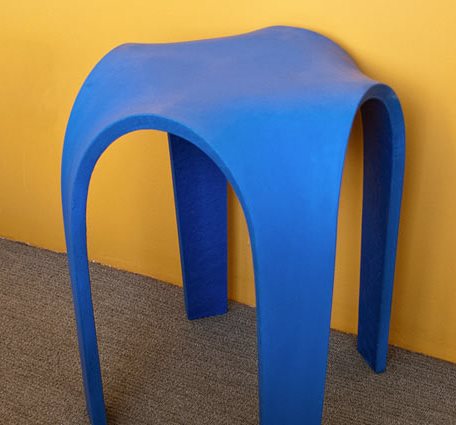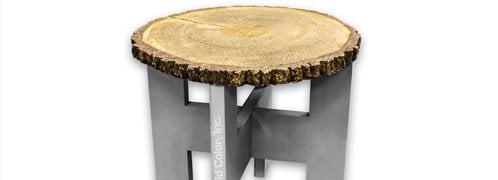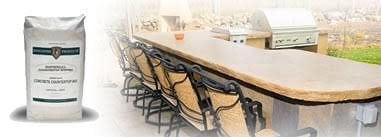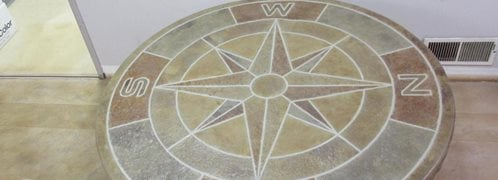- Concrete Furniture Home
- Concrete Furniture Photos
- Concrete Furniture Types
- Concrete Coffee Tables
- Outdoor Concrete Furniture
- Concrete Office Furniture
- Concrete Storage Furniture
- Concrete Ping Pong Tables
- Design Ideas
- Concrete Furniture Design Ideas: Behind-the-scenes info and photos
- Free Concrete Furniture Catalog
- Related Information
- Learn How to Make Bent Concrete Furniture
- Concrete Contractors: Find GFRC Mixes for Precast Concrete
How to Make Bent Concrete Furniture
Instructions for bending concrete while it's still plastic to create unique curved pieces
Put some curves into your concrete furniture by bending the concrete before it sets. You’ll need a flexible rubber or plastic mold, a fast-setting glass-fiber-reinforced concrete mix, and precise timing to achieve successful results. This contemporary concrete side table was made using the Xtreme GFRC precast mix and modifier from SureCrete, a polyurethane rubber mold, and CHENG SmartColor integral pigment.
We all know that one of the best attributes of fresh concrete is its ability to be molded into any shape. But did you know that with the right concrete mix and a flexible mold, you can also bend concrete while it’s still plastic to form unique curved tables, flower pots, chairs, and other decorative furnishings?
The secret is to use a glass-fiber-reinforced concrete mix and a performance-enhancing GFRC admixture that reduces shrinkage and speeds the setting time, such as Xtreme GFRC precast mix and modifier from Surecrete. “The heavy concentration of fine fiber blends prevents tearing or cracking when bending the concrete as it enters a plastic state while ensuring tremendous flexural strength after the concrete is cured,” says Mike Heidebrink, president of CHENG Concrete, which has step-by-step instructions on its website for using the mix to make a bent concrete side table.
The site also includes instructions for constructing a bendable mold using a liquid polyurethane rubber, which is key to achieving successful results. “Bending concrete isn't difficult, but making the molds to create good-looking castings is. Like casting any other concrete mix, the mold construction and surface quality will have a tremendous effect on the finished aesthetic,” says Heidebrink.
Once you make the bendable rubber mold, the trickiest part of the process is the timing. After you pour the concrete mix into the mold, you must bend it into the desired shape as soon as the concrete reaches its optimal plastic state. If you try to bend the mold too soon, the concrete will slump down into a pile. If you wait too long, the concrete will crack at the curvatures in the mold.
“When we work with Surecrete's Xtreme precast mix, we allow the concrete to rest for at least 20 minutes before checking its plasticity by bending the mold to a vertical position and checking to see if the concrete pulls away from the form or slumps,” Heidebrink explains. “If this occurs, we simply lay the form back to its original position and wait another 5 minutes before checking the plasticity again. The window of optimal plasticity lasts about 15 minutes, but if we miss the mark and the mix has set too much, it can be re-liquefied by vibration up to 45 minutes after casting.”
In addition to furniture, bendable concrete can also be used to make curved sinks, countertops, and tile and wall panels. “Large sculptural forms can easily be created by pouring flat panels on flexible forms that are later manipulated when the concrete mix has reached a malleable plastic state,” says Heidebrink.
To see the bending process in action, watch these videos showing you the entire process:
Bending Concrete into Furniture (from SureCrete)
Warping GFRC Concrete and Making a Warped Concrete Coffee Table (from Trinic LLC)
If you think the ability to bend fresh concrete is pretty amazing, there's also ongoing research into special concretes (also called engineered cement composites, or ECC) that can bend and even self-heal after they've hardened. Some of the applications include beams in high-rise buildings, dam walls, and bridge decks. To learn more, check out this video from the University of Michigan.
 Urethane Furniture Molds
Log tables, benches and more
Urethane Furniture Molds
Log tables, benches and more
 Imperial Mix
Lightweight, strong, minimal shrinkage
Imperial Mix
Lightweight, strong, minimal shrinkage
 Table Top Molds
Live edge, compass, flags, checkboard, etc.
Table Top Molds
Live edge, compass, flags, checkboard, etc.




